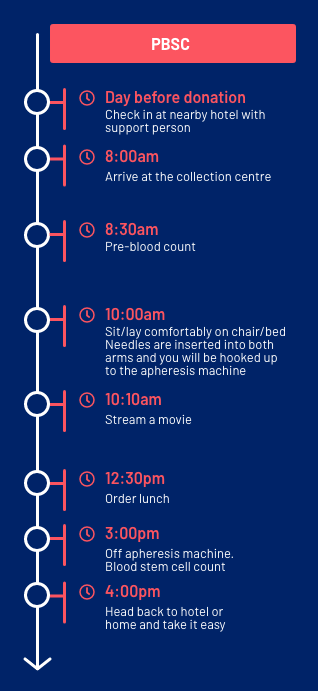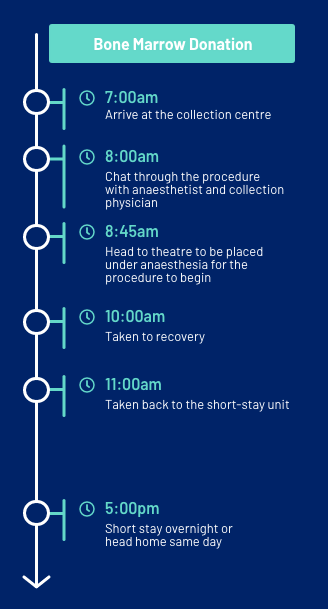The donation process
If you’re a registered blood stem cell donor and you’ve been identified as a potential match, here is a typical breakdown of the process you could take.
You’re identified as a potential match
The process begins when we search all donors on our registry to see which donors are potential matches for a patient.
For each patient we might find hundreds of potential matches; or we might find only a few. Even when we do find multiple potential matches, only a handful of these matches will be suitable and available to proceed.
We then call the best-matched donors to let them know the exciting news, talk them through the next steps and make sure they’re comfortable to proceed.
After the call, donors are sent a detailed questionnaire about their health. They will also be asked to provide some blood samples, which the patient’s medical team will test to clinically verify the match and check for infectious diseases. This is to make sure any donation is safe for both the donor and the patient.
The patient’s medical team use these blood test results to select which donor, if any, is most suitable for their patient.
The total time required for testing and donation is approximately 16 hours over several weeks.
Watch our Verification Testing video to find out more.
You attend Workup & you're cleared to donate
The Workup stage involves an appointment where potential donors undergo a comprehensive assessment to ensure they are fit for donation.
This appointment typically includes a physical examination and an information session led by a medical professional. It is an essential opportunity for donors to learn about the donation and transplant process, ensuring they feel fully informed and comfortable moving forward.
During the appointment, donors will complete a health questionnaire and undergo a physical examination, which may include the following:
- Chest x-ray
- ECG
- Taking blood samples
- Assessment of veins
- Assessment of general anaesthetic risk
- If a donor is female, they will be asked to take a pregnancy test
Watch our Workup and donation preparation video to find out more.
The donation method is selected – PBSC
You will be informed about the donation method chosen by the patient’s medical team based on their specific needs.
Donation method 1: PBSC
The most common method is a Peripheral Blood Stem Cell (PBSC) donation. A few days prior to the donation, the donor will receive injections of G-CSF (Granulocyte colony-stimulating factor) to increase the level of stem cells in their blood.
On the day of donation, the procedure is performed as an outpatient treatment. A needle will be placed in each arm: one arm will draw blood, which is processed through an apheresis machine to collect the stem cells, while the remaining blood is returned to the other arm.
The duration of this procedure typically ranges from four to six hours, depending on the number of stem cells needed for the patient. If the required number of stem cells is not collected in one session, the donor may be asked to return for a second day of donation.
The donation method is selected – bone marrow
You will be informed about the donation method chosen by the patient’s medical team based on their specific needs.
Donation method 2: Bone marrow donation
Bone marrow is typically collected from the hips while the donor is under general anaesthesia. This method is often requested for paediatric patients. Depending on the collection centre, being under general anaesthesia may require an overnight stay before or after the procedure; however, some centres may allow donors to return home the same day.
Preparation for bone marrow donation does not require any special injections beforehand. During the procedure, a thin needle is inserted into the back of the pelvis, and a syringe is used to draw out the liquid bone marrow. The body naturally replenishes the donated bone marrow within approximately four weeks.
You prepare for donation
Peripheral Blood Stem Cell (PBSC) donation preparation
For PBSC donation, donors will need to inject G-CSF (Granulocyte Colony-Stimulating Factor) for four days prior to their donation. G-CSF is a synthetic version of a protein that occurs naturally in the body and plays a crucial role in stimulating the production of stem cells. This medication helps encourage bone marrow cells to move into the bloodstream, increasing the number of available stem cells for donation.
The G-CSF injections are administered under the skin, similar to how insulin is injected for diabetes. A medical professional, such as a nurse or GP, will usually oversee the first injection and provide training for self-administration for the subsequent doses. The donation will take place on the fifth day after the injections begin.
Bone marrow donation preparation
No special preparations or injections are required for bone marrow donation. The collection centre will inform donors about any necessary steps to take before the donation day.
Donation day – PBSC
Here is an example of a donation day. Please note that a donation day may not happen at these times or in this order.

Donation day – bone marrow
Here is an example of a donation day. Please note that a donation day may not happen at these times or in this order.

You recover and we'll check in
No two people feel the same after donating. Some may feel tired, while others ache. Some feel completely fine. After donation, the main thing is to rest and take it easy for a couple of days.
Both donation methods have slightly different symptoms because of how they are carried out. For PBSC, a donor may feel mild flu-like symptoms such as a headache, muscle, and bone pain, bruising or feeling tired. For bone marrow donation, symptoms can range from back/hip pain, stiffness to fatigue and/or bruising around the back of the hips. Most symptoms disappear after a few days; however, a Donor Support Coordinator will be in touch after donation to check in.
We regularly check in with donors hours and days after they have donated. We want to keep in touch and see how a donor is feeling. A Donor Support Coordinator will follow up with a donor weekly until they resume normal activity. There are key times when we will reach out to donors:
- 24-72 hours after donation
- 1-3 weeks post-donation
- Three months usually with a GP
- Annual follow-up for ten years
Mononuclear Cells (MNC) Apheresis Donation
Sometimes a recipient may need white blood cells (lymphocytes) from their donor. This is called a Donor lymphocyte Infusion (DLI) which is collected via an MNC Apheresis procedure. This type of donation can be requested within months of the transplant or several years later and is primarily requested to boost the patient’s recovery after their transplant.
Preparation for this is more straightforward and doesn’t require any injections. White blood cells are removed from your blood via apheresis and can take approximately four to five hours. The donation usually takes place at the same collection centre as your previous donation.
Donor-patient timeline
The patient and donor journeys are interlinked. Each stage has implications for both. Sometimes a donor may be waiting a while to proceed to the next step as a patient completes theirs and vice versa.
Our interactive timeline summarises the steps the patient and donor go through leading up to and beyond donation day.

Donor resources
There are a couple of steps you will need to go through before donating. These steps ensure you’re the right match for a patient and are designed to keep you and the recipient safe.
Donor resources are provided to help you understand the journey and prepare you for what to expect. There are factsheets, videos, and other resources to help you feel informed.

FAQs
We have a dedicated FAQ section for donors. Take a look!
View donor FAQsUpdate details
It’s really important to keep your registry details up to date.
Update now